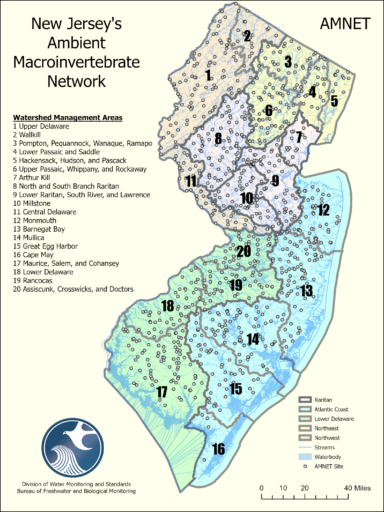
Ambient Macroinvertebrate Network (AMNET)
The AMNET program has established sampling stations on non-tidal freshwater rivers and streams in each of New Jersey’s 20 Watershed Management Areas to enable assessments for the Water Region, WMA and subwatershed, as well as at an overall statewide scale. The network was initiated in the early 1990’s and currently includes over 750 sites. The full complement of sites within each of the State’s five Water Regions is sampled once every five years, on a rotational schedule, providing a snapshot of conditions.
The methods and the assessment approach are based on the USEPA’s Rapid Bioassessment Protocols. Macroinvertebrates are collected in the field using established protocols with a D-frame dipnet, commonly referred to as a D-net. Samples are preserved in the field and analyzed at the BFBM Laboratory in Ewing. In addition to the macroinvertebrate sample, at each site, a visual-based habitat assessment is performed and other physical/chemical parameters are collected such as pH, dissolved oxygen, specific conductivity, water temperature, turbidity, and nutrients. This additional data is collected to aid in evaluation and assessment of the macroinvertebrate data analysis.
DEP uses of AMNET program data:
- Assessing Aquatic Life Use attainment in the biennial Integrated Water Quality Monitoring and Assessment Report
- Designation of Category 1 waters (high quality special protection waters), based on “Exceptional Ecologically Significance”
- Evaluating freshwater ecological health in DEP’s Environmental Trends report
Macroinvertebrate Identification Video
In 1992, the Bureau of Freshwater & Biological Monitoring reactivated its Ambient Macroinvertebrate Network (AMNET) which, at the time of its last sampling in 1988, consisted of only 18 sampling sites statewide. The old network was determined to be inadequate to support the department’s 305(b) [water quality inventory report], 303(d) [list of impaired waters] and watershed programs, so bureau staff designed a new program.
The new AMNET program established sampling stations in each of the 20 freshwater Watershed Management Areas , statewide, where the health of in-stream benthic macroinvertebrate (sometimes called bottom-dwelling “bugs”) communities are evaluated using a USEPA – developed statistical methodology referred to as Rapid Bioassessment Protocol (RBP) . Under AMNET, each of the State’s five major Water Regions is sampled for benthic macroinvertebrates (bottom dwelling organisms visible to the naked eye) on a rotational schedule of once every five years. Visual observations, Stream Habitat Assessments and limited physical/chemical parameters are performed on each site. To date, all of the major drainage basins have been biologically monitored for the third time with over 760 non-tidal sampling sites established.
The AMNET results have been incorporated into the National Environmental Performance Partnership System (NEPPS) as a primary environmental indicator of water quality impairment. Statewide AMNET monitoring is a commitment in the NEPPS PPA with EPA Region 2, and a key element of NJ’s Long-term Water Monitoring and Assessment Strategy. Other uses of the AMNET data include:
- Evaluating attainment of aquatic life uses
- Biennial statewide Integrated Water Quality Assessment Report
- Designation of Exceptional Ecologically Significant special protected waters referred to as Category 1 waters
- DEP’s Environmental Trends report
The major goal of AMNET is to provide a cost efficient means of gauging the quality of surface water and watershed areas throughout the state. This is done through biological sampling and analysis of macroinvertebrate communities from a network of stream sites that adequately represents New Jersey’s major drainage basins and NJDEP’s Watershed Management Areas (WMAs). Currently there are currently twenty (20) WMAs within New Jersey’s five (5) major basins [Upper Delaware (aka Northwest), Lower Delaware, Northeast, Raritan, and Atlantic]. Each major basin is also known as a “Water Region”. Each of the 20 WMAs are a sub-basin of a Water Region. There are an average of 150 AMNET sites in each Water Region with a statewide total of over 750 sites.
AMNET uses in-stream populations of benthic macroinvertebrates as indicators of water quality. Benthic (bottom-dwelling) macroinvertebrates are macroscopic (visible to the naked eye) invertebrate (lacking backbone) organisms inhabiting all types of aquatic habitats. In freshwater rivers and streams, common forms are aquatic insects, worms, snails and crustaceans. Macroinvertebrates are commonly found throughout the state’s streams, fulfilling an important role in the aquatic food web. Species comprising the instream macroinvertebrate community occupy distinct niches (living spaces) governed by environmental conditions and their tolerance to stressors, such as pollutants, habitat alterations, or other factors such as streamflow and water temperature. Changes in environmental conditions are reflected in changes in macroinvertebrate community structure. These changes in the macroinvertebrate community structure are measured and assessed using standardized metrics, which are incorporated into an overall index of the ambient water quality.
Biological communities reflect the overall ecological integrity of a river or stream, and integrate the effects of different stressors, providing a broad measure of their aggregate impact. Benthic macroinvertebrates are good indications of localized conditions because they are relatively sessile, or immobile. Therefore, the composition of a stream benthic macroinvertebrate community can be used to assess the effects of both short-term and long-term variations in water quality, as well as habitat quality. The primary goal of AMNET is to provide a long-term, cost-efficient means of gauging the quality of surface waters and watershed areas throughout the State . The data generated by AMNET is issued in the DEP’s preparation of the biennial “Integrated Water Quality Monitoring and Assessment Report” (includes 305(b) Report and 303(d) List). The information is also used to help determine the waterbodies that should be given Category One protection based on “exceptional ecological significance”. The Category One designation provides special protection for high-quality waters to protect against degradation.
Below is a list of the main steps taken in sample collection, identification, and analysis performed by the AMNET program at the Bureau of Freshwater and Biological Monitoring.
A Standard Operating Procedure (SOP) is available for all aspects of the AMNET program including sampling, analysis, and assessment.
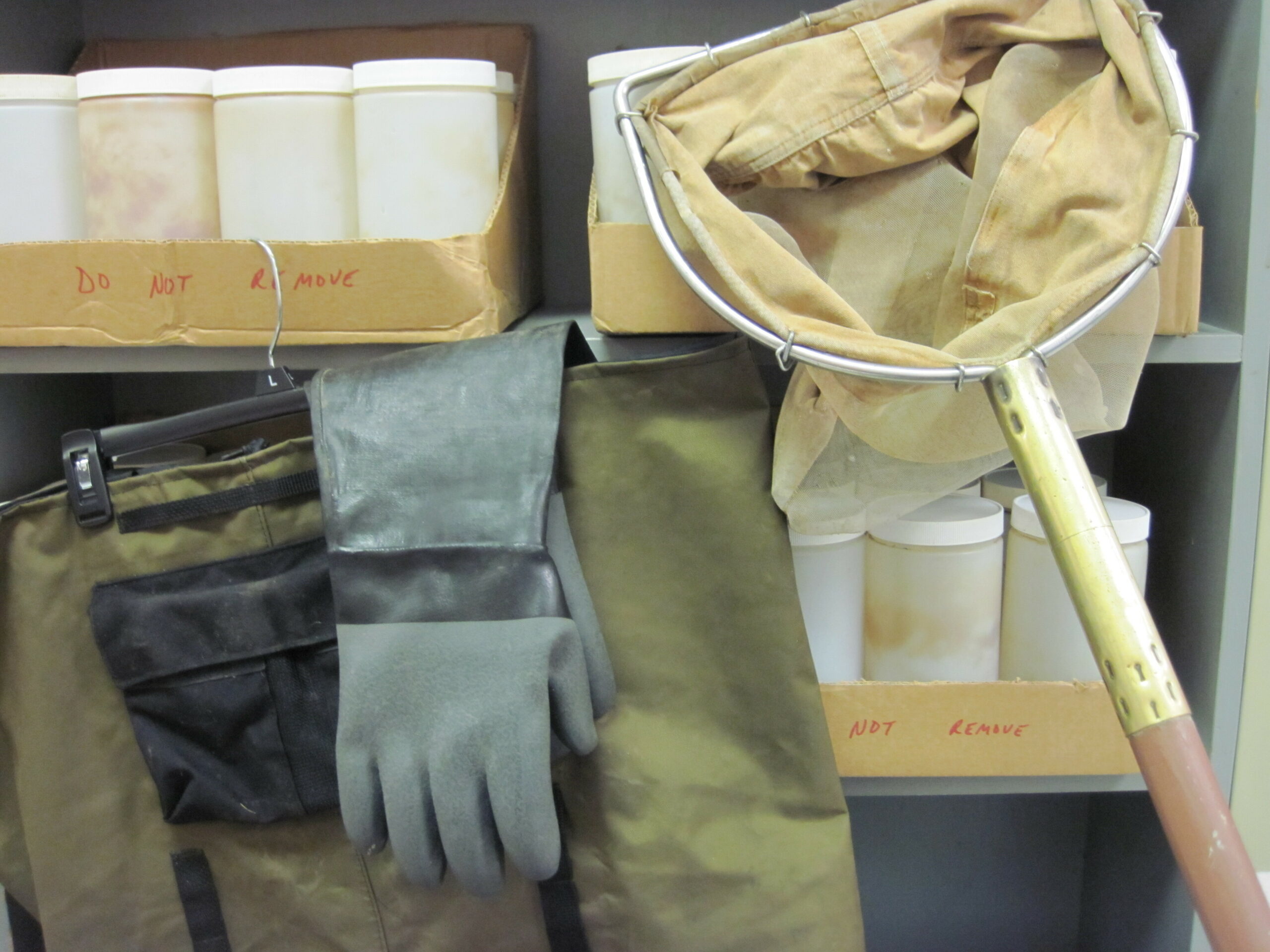
Benthic macroinvertebrate samples are collected using a 800 x 900 mesh D-net placed on the stream bottom. A sampler, standing upstream of the net, disturbs the stream bottom with their boot using the Kick method and collects the dislodged debris and macroinvertebrates that flow into the net. A riffle/run area is the ideal substrate in which to collect macroinvertebrates. It provides stable habitat in the form of large rocks and cobbles and is usually well oxygenated. Macroinvertebrate samples are also collected from Submerged Aquatic Vegetation (SAV) by sweeping the net through the SAV, combining the contents of the sample with the kick sample. Other areas such as root mats and undercut banks may also be sampled if present. In slower moving low gradient streams, riffle areas are usually not present, therefore, it will be necessary to sample with a multihabitat jab and sweep method. Contents of all samples in net are transferred to a sieve bucket and rinsed in stream water to remove fine sediment. The remaining sample is transferred to 1 liter, plastic collection bottles and preserved with formaldehyde for a 5-10 % final concentration. Samples are returned to the lab for sorting and identification.

NJDEP utilizes a multi-probe meter to measure Water Temperature, pH, Dissolved oxygen (DO), and Specific Conductivity. A sample is also collected for Turbidity testing using a portable turbidity meter. Nutrients samples are also collected and delivered to the NJ Department of Health for analysis.
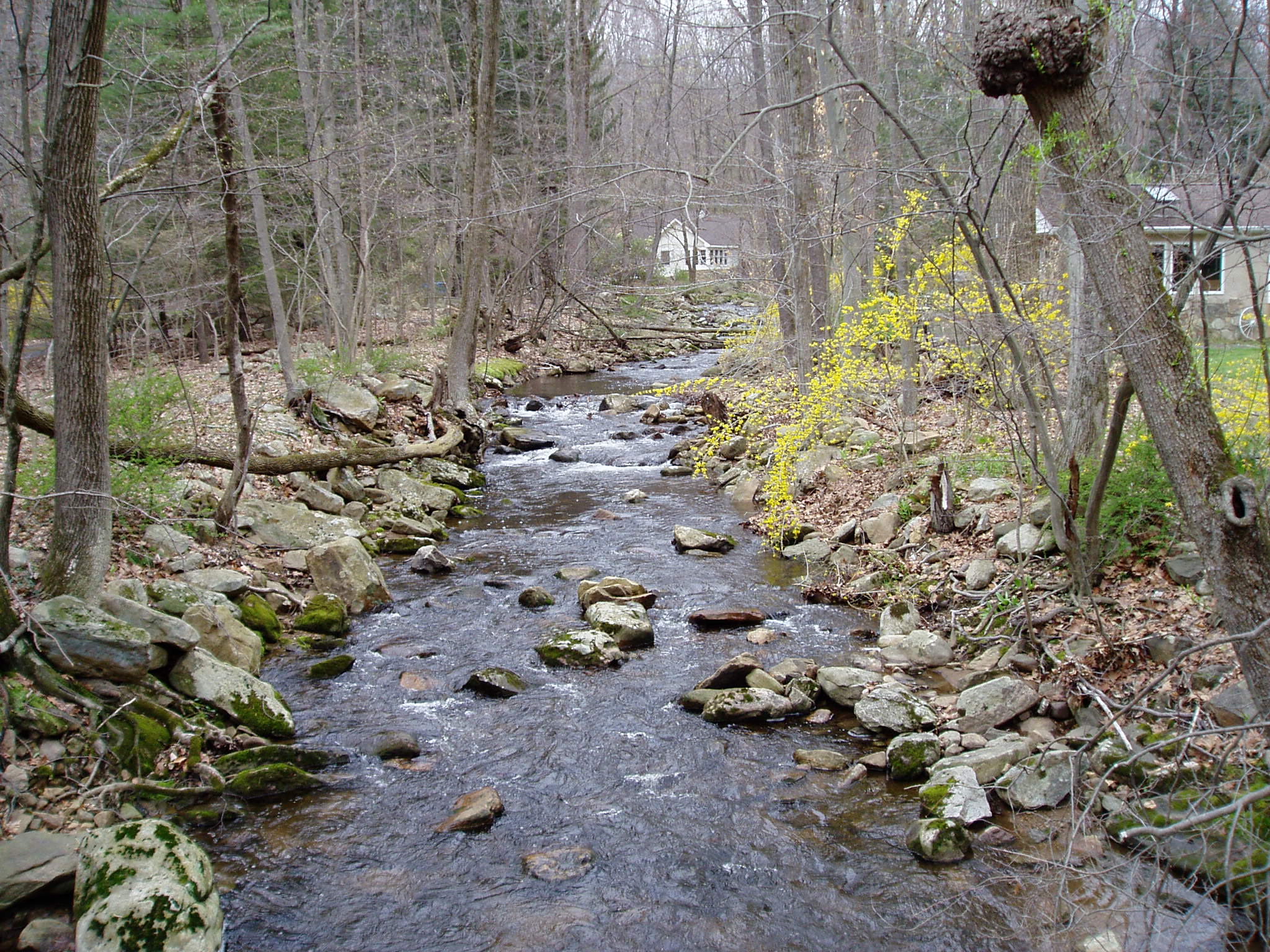
The land surrounding the stream to be sampled can have an impact on the type of macroinvertebrates found at the site. A stream habitat assessment is performed at each site using the EPA Habitat assessment form for either a High gradient stream or Low gradient streams. Ten habitat parameters are assessed by the field staff to determine an overall Stream Habitat Assessment. Final score determines one of four habitat assessment ratings, namely: Optimal, Suboptimal, Marginal, or Poor. Other site observations are also recorded. This may offer a more complete picture as to the health of a stream.
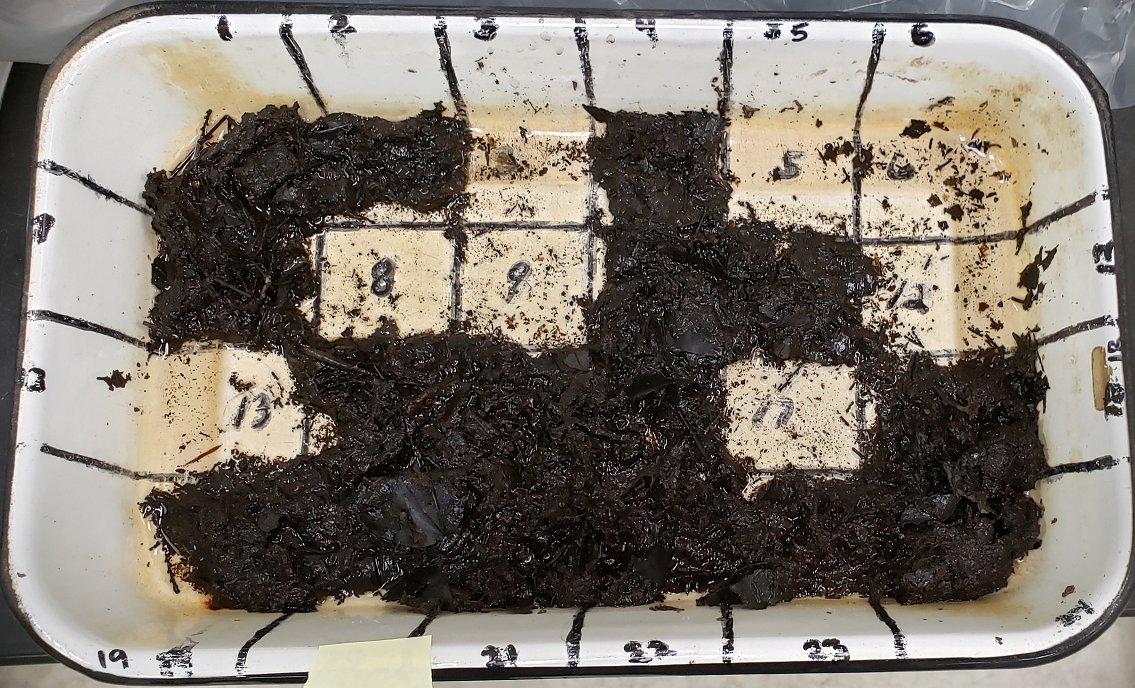
Samples are returned to the NJDEP lab and macroinvertebrates are stored until chemically fixed (preserved). Once samples are completely fixed, samples are rinsed of excess formaldehyde and placed into a gridded tray. A grid is randomly selected using a random number table and all material within the grid is transferred to a Petri dish. The material in the dish is examined under low power (6.3x) using a stereo microscope. All organisms in a grid are collected and counted, and the process continues to the next randomly selected grid. This process continues until at least a 100 organism subsample is collected. Then each macroinvertebrate is identified using a Leica Model MZ6 stereo microscope capable of up to 40x magnification. A compound microscope with 100x, 200x, 400x, and 1000x magnification is used for very detailed identification. An extensive library of dichotomous keys reference documents is used to determine final identification down to the practicable taxonomic level. A full list of our dichotomous key documents can be found on the Reports page.
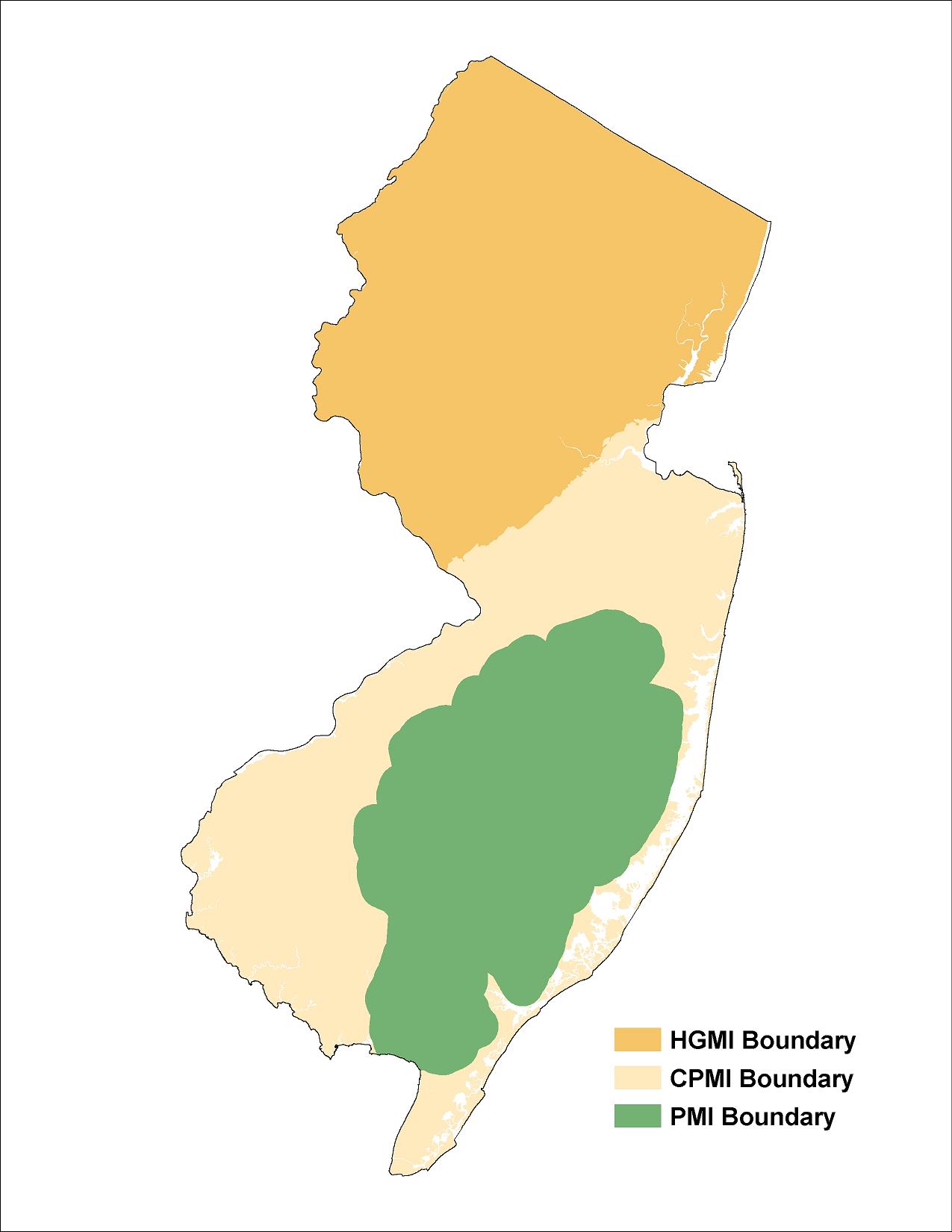
AMNET employs a multimetric index approach for assessment of biological condition, and regulatory thresholds for use attainment. Once all organisms have been identified, each taxa and count in a sample is entered into the Bureau’s Rapid Bioassessment Protocol (RBP Analysis) database. The RBP Analysis Program creates a random, 100 individual, subsample and calculates a bioassessment rating using the appropriate regional multi-metric index. New Jersey benthic macroinvertebrate communities can be statistically grouped into three distinct structures based on geographical regions: high gradient (above the Fall Line), low gradient (Coastal Plain excluding the Pinelands), and Pinelands. To accurately assess biological condition, an index was developed for each distinct region using guidelines outlined in USEPA's Rapid Bioassessment Protocols (RBP) for Use in Wadeable Streams and Rivers. The impairment indices assess sites from two perspectives: the condition of the macroinvertebrate community and the regulatory use attainment. An assessment framework was outlined to address both concerns, and a development report was prepared for each index: High Gradient Macroinvertebrate Index (HGMI), Coastal Plain Macroinvertebrate Index (CPMI), and the Pinelands Macroinvertebrate Index (PMI).
A summary of the index development and scoring criteria can be found in Appendix B of the AMNET SOP.
Below is a list of the other macroinvertebrate related projects performed by the AMNET program staff at the Bureau of Freshwater and Biological Monitoring.

The objectives of the PWQBN are to:
- establish a probabilistic network of sites to determine statewide estimates of biological impairment in a statistically sound manner; and
- collect habitat and biological samples (macroinvertebrates) to link biological conditions to water quality at Ambient Surface Water Quality Monitoring Network (ASWQMN) probabilistic sites, where co-located
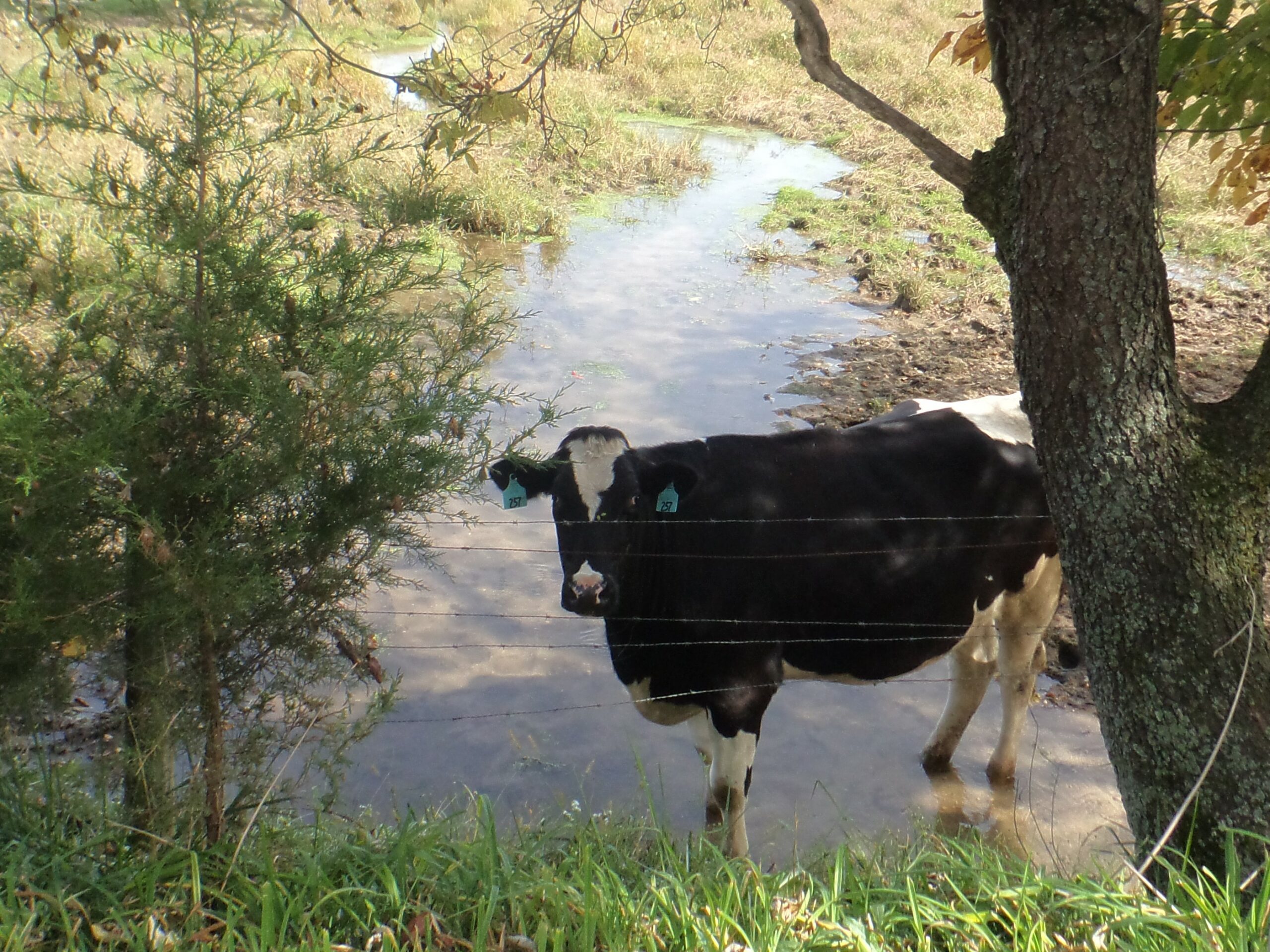
The National Water Quality Initiative (NWQI) is a joint project of the USEPA and the USDA. The USDA's National Resources Conservation Service (NRCS) is providing financial assistance to farmers and ranchers throughout the Nation to implement conservation practices aimed at reducing nutrients, sediment, and pathogens in rivers and streams from agricultural lands. Three watersheds (HUC12s) were selected in New Jersey to receive this funding. With USEPA guidance, one of these watersheds, the Upper Salem River, was selected to receive focused monitoring, conducted by NJDEP-BFBM, to assess the effectiveness of these conservation practices in the watershed. Benthic macroinvertebrates will be sampled once a year for this project by BFBM from all sites. Along with the macroinvertebrate samples, there will also be nutrient, bacteriological, and chemical physical parameters collected for this initiative.
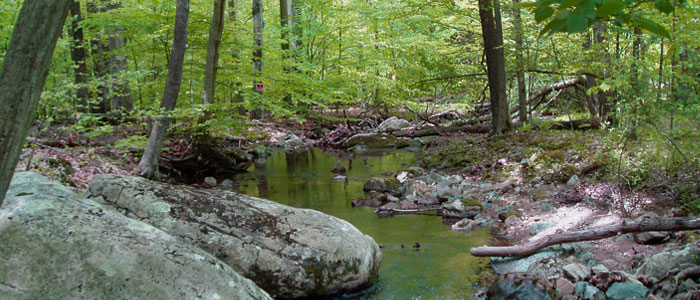
The United States Environmental Protection Agency (EPA) is working with its regional offices, states, tribes, and other entities to establish Regional Monitoring Networks (RMNs). The RMNs will help EPA and their partners collect current, baseline biological, thermal, and hydrologic data from freshwater wadeable streams. Benthic macroinvertebrates will be sampled once a year for this project by BFBM from all sites. Along with the macroinvertebrate samples, there will also be nutrient and chemical physical parameters collected for this initiative. This information will be used to help quantify and detect long-term changes in conditions of high-quality streams. Detection of such changes can inform water quality criteria and indicator development, as well as responses to climate change effects.
- AMNET Standard Operating Procedure (SOP)
- Multi Metric Assessment Scoring Criteria
- High Gradient Macroinvertebrate Index (HGMI) Development
- Coastal Plain Macroinvertebrate Index (CPMI) Development
- Pinelands Macroinvertebrate Index (PMI) Development
- Taxonomic Reference List
- Stream Habitat Assessment Form
